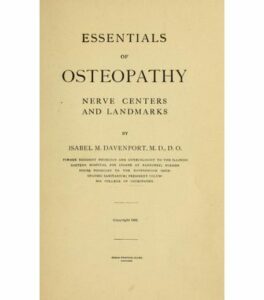Essentials of Osteopathy, Nerve Centers and Landmarks by Isabel Montgomery Davenport
A short volume, divided into 23 lessons, in which the author summarizes the essence of the osteopathic theory in an extremely simplistic manner, the modalities implemented when visiting a patient, nerve connections and anatomical landmarks.

Publisher: Regan Printing House, Chicago, Illinois (USA)
Year of publication: 1903
Number of pages: 112
This booklet was destined to the students enrolled in an osteopathy course by correspondence of the Columbia College of Osteopathy of Ravensburg, Chicago. Dr Davenport repeatedly cites the Principles of Osteopathy by Charles Hazzard, expressing towards the author admiration and gratitude.
The volume makes no claim of originality: it is openly a user-friendly summary for the professional.
In the wake of the success of the American School of Osteopathy (ASO) of Kirksville, numerous courses and institutes of osteopathy of dubious professionalism proliferated, which discredited the category of osteopaths by producing poorly trained practitioners. The AOA prepared a letter to send to various magazines for them to refuse to publish commercials of these diploma mills, some of which would award their degrees by correspondence. Amongst the other initiatives, the ASO promoted another institution (the Associated Colleges of Osteopathy), established in June 1898, with the aim to safeguard the reliability of education.1
Strengths: Of easy reference, this booklet features an analytical index. A small guide with a very practical perspective.
Weaknesses: A concise volume, without figures or anatomical tables. The interest is mainly historical, linked to the phenomenon of the proliferation of schools offering correspondence courses on the wave of the success of the ASO of Kirksville.
- Despite the title awarded by non authorized institutions, at the beginning the osteopaths were often sued to then be discharged by the judges. For example, in the Reports of cases of the State of North Carolina, year 1902, the dispute “STATE v. McKNIGHT” is registered. Harry P. McKnight, with a diploma of the Columbia College of Osteopathy, accused of illicit exercise of the medical profession, is acquitted because in his activity of manipulation, massage, hot and cold baths, he did not prescribe any drugs (Walser, Zeb V. State Reporter. North Carolina Reports vol. 131. Cases argued and determined in the Supreme Court of North Carolina. August Term, 1902. Raleigh: Edwards & Broughton, State Printers, 1902, vol. V:717-724.
- Despite the efforts of the most serious institutions, these diploma mills continued to survive, as shown by the commercial of a home course in osteopathy, which appeared on the Nautilus Magazine of New Thought, v.7 no.12, 1904/05:
- Booth E.R. History of Osteopathy and Twentieth-Century Medical Practice. The Caxton Press, Cincinnati, Ohio (USA), 1924:271ss.

Are you an osteopath?
Register and enjoy the membership benefits. Create your public profile and publish your studies. It's free!
Register now
School or training institution?
Register and enjoy the membership benefits. Create your public profile and publish your studies. It's free!
Register now
Do you want to become an osteopath? Are you a student?
Register and enjoy the membership benefits. Create your public profile and publish your studies. It's free!
Register nowHistorical osteopathy books
Osteopathy Research and Practice by Andrew Taylor Still
The fourth book of A.T. Still, written at the age of 82 years, enunciates the principles and the practical maneuvers of osteopathy in reference to the single pathologies, classified by body regions.
ReadHistory of Osteopathy and Twentieth-Century Medical Practice by Emmons Rutledge Booth
A milestone in the history of osteopathy. Emmons Rutledge Booth, who enrolled at the ASO in Kirksville in 1898 and graduated in 1900, met A.T. Still personally.
ReadPhilosophy of Osteopathy by Andrew Taylor Still
The second book published by A.T. Still, it collects the basic principles of osteopathy, written over several years and then gathered in one volume. Despite the insistence of his friends, Still was not sure that the time was ripe to divulge his early science.
ReadAutobiography of Andrew Taylor Still with a History of the Discovery and Development of the Science of Osteopathy by A. T. Still
A fundamental text to begin to know the founder of osteopathy and to understand the cultural context and the historical events during which his life unfolded.
ReadPrimitive Physick: or, an Easy and Natural Method of Curing most Diseases by John Wesley
A fundamental text for the Methodists, which Still’s father surely knew and probably owned - in addition to remedies, the book contains a preface that dispenses advice for a healthy life.
ReadThe Old Doctor by Leon Elwin Page
A small volume dedicated to the story of Andrew Taylor Still, and to the birth and development of the idea of osteopathy.
ReadThe Cure of Disease by Osteopathy, Hydropathy and Hygiene A Book for the People by Ferdinand L. Matthay
A small volume addressed to the general public, dispensing health advice and illustrating some osteopathic techniques.
ReadOsteopathy; the New Science by William Livingston Harlan
The volume collects and comments a series of relevant articles on the new science of osteopathy, highlighting legal, historical and theoretical aspects.
ReadA Manual of Osteopathy – with the Application of Physical Culture, Baths and Diet by Eduard W Goetz
Very schematic volume, with the aim of spreading the osteopathic application techniques to everybody, even to those lacking any sort of health training.
Read







